The AMD Llano Notebook Review: Competing in the Mobile Market
by Jarred Walton & Anand Lal Shimpi on June 14, 2011 12:01 AM EST
High Detail Gaming and Asymmetrical CrossFire Misfire
Update, 8/10/2011: Just to let you know, AMD managed to get me a new BIOS to address some of the rendering issues I experienced with CrossFire. As you'll read below, I had problems in several titles, and I still take exception with the "DX10/11 only" approach. I can name dozens of good games out there that are DX9-only that released in the past year. Anyway, the updated BIOS has at least addressed the rendering errors I noticed, so retail Asymmetrical CrossFire laptops should do better. With that disclaimer out of the way, here's my initial experience from two months back.
So far, the story for Llano and gaming has been quite good. The notebook we received comes with the 6620G fGPU along with a 6630M dGPU, though, and AMD has enabled Asymmetrical CrossFire...sort of. The results for ACF in 3DMarks were interesting if only academic, so now we're going to look at how Llano performs with ACF enabled and running at our High detail settings (using an external LCD).
Just a warning before we get to the charts: this is preproduction hardware, and AMD informed us (post-review) that they stopped worrying about fixing BIOS issues on this particular laptop because it isn't going to see production. AMD sent us an updated driver late last week that was supposed to address some of the CrossFire issues, but in our experience it didn’t help and actually hurt in a few titles. Given that the heart of the problem is in the current BIOS, that might also explain why Turbo Core doesn't seem to be working as well as we would expect.
AMD also notes that the current ACF implementation only works on DX10/11 games, and at present that's their plan going forwards as the majority of software vendors state they will be moving to DX10/11. While the future might be a DX10/11 world, the fact is that many recent titles are still DX9 only. Even at our "High" settings, five of our ten titles are tested in DX9 mode (DiRT 2, L4D2, Mafia II, Mass Effect 2, and StarCraft II—lots of twos in there, I know!), so they shouldn't show any improvement...and they don't. Of those five titles, four don't have any support for DX10/11 (DiRT 2 being the exception), and even very recent, high-profile games are still shipping in DX9 form (e.g. Crysis 2, though a DX11 patch is still in the works). Not showing an improvement is one thing, but as we'll see in a moment, enabling CrossFire mode actually reduces performance by 10-15% relative to the dGPU. That's the bad news. The good news is that the other half of the games show moderate performance increases over the dGPU.
If that doesn't make the situation patently clear, CrossFire on our test unit is largely not in what we consider a working state. With that out of the way, here are the results we did managed to cobble together:
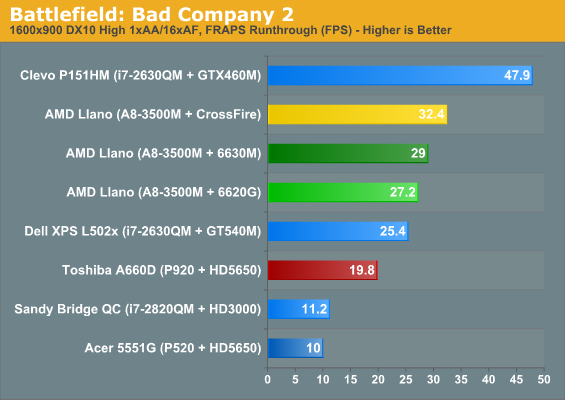
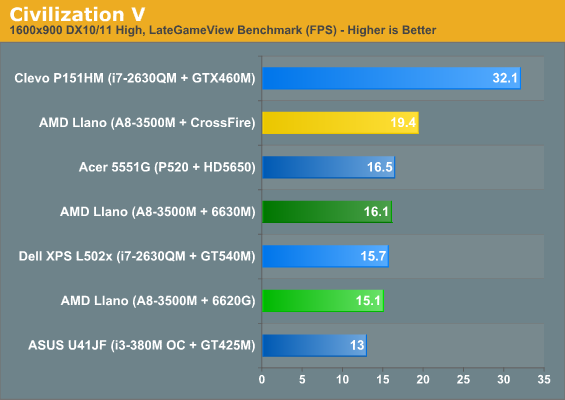
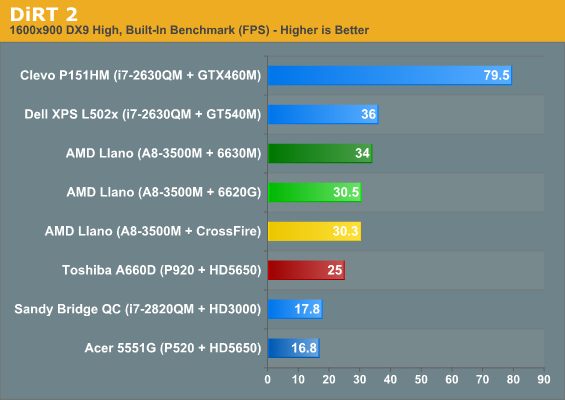
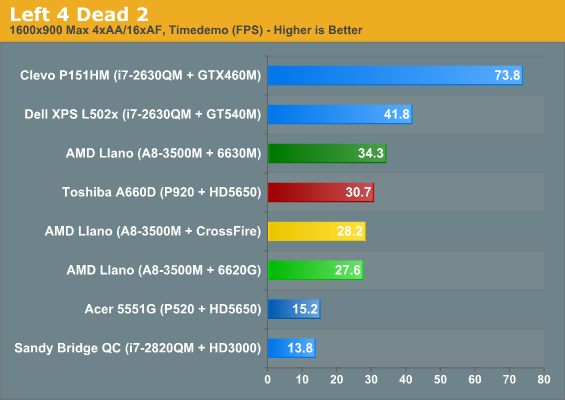
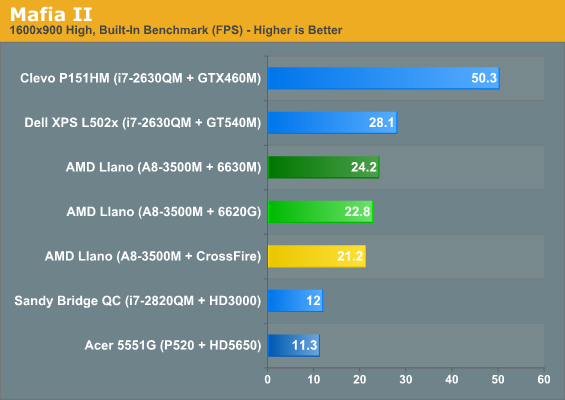

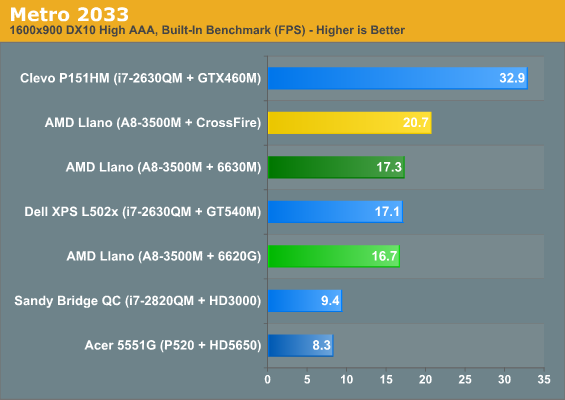
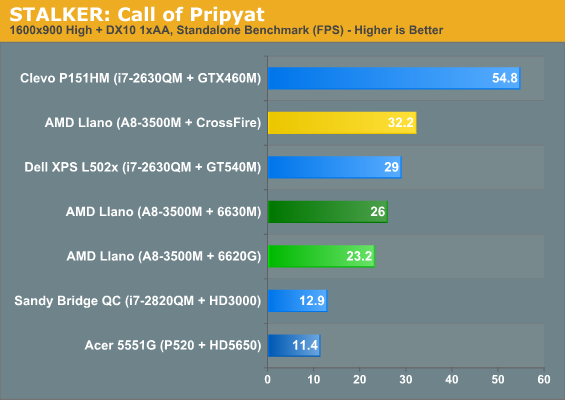
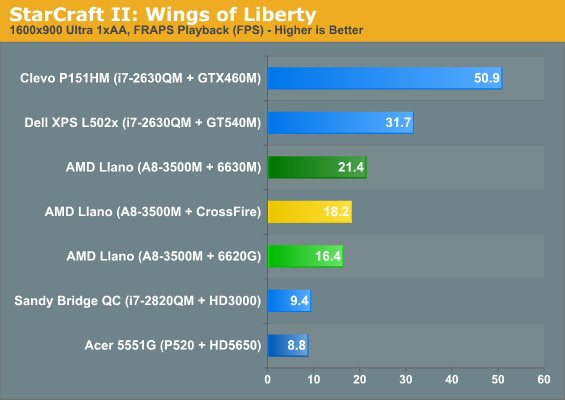
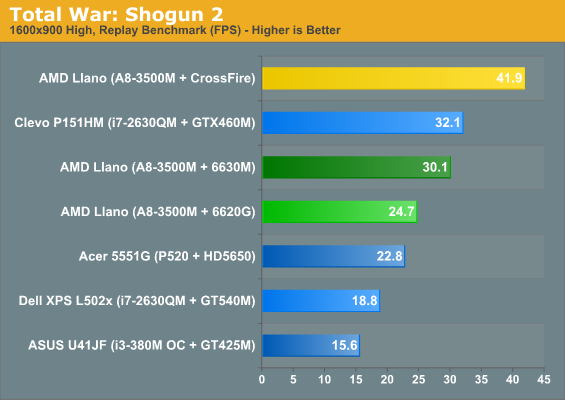
Given this is preproduction hardware that won't see a store shelf, the above results are almost meaningless. If ACF can provide at least a 30% increase on average, like what we see in TWS2, it could be useful. If it can't do at least 30%, it seems like switchable graphics with an HD 6730M would be less problematic and provide better performance. The only takeaway we have right now is that ACF is largely not working on this particular unit. Shipping hardware and drivers should be better (they could hardly be worse), but let's just do a quick discussion of the results.
If we just look at games with DX10/11 enabled, the story isn't too bad. Not accounting for the rendering issues noted below, ACF is able to boost performance by an average of 24% over the dGPU at our High settings. We didn’t include the Low and Medium results for ACF on the previous page for what should be obvious reasons, but if the results at our High settings are less than stellar, Low and Medium settings are even less impressive. Trimming our list of titles to three games (we tested TWS2 and STALKER in DX9 mode at our Low and Medium settings), ACF manages to average a 1% performance increase over the dGPU at Low and a 14% increase at Medium, but Civ5 still had to contend with rendering errors and Metro 2033 showed reduced performance.
In terms of rendering quality, ACF is very buggy on the test system; the default BIOS settings initially resulted in corrupted output for most games and 3D apps, but even with the correct settings we still encountered plenty of rendering errors. Civilization V only had one GPU rendering everything properly while units were missing on the other GPU, so you’d get a flicker every other frame with units appearing/disappearing. At higher detail settings, the corruption was even more severe. STALKER: Call of Pripyat and Total War: Shogun 2 also had rendering errors/flickering at higher quality settings. Since we didn't enable DX10/11 until our High defaults, right when ACF is supposed to start helping is where we encountered rendering issues.
Just to be clear: none of this means that Asymmetrical CrossFire is a bad idea; it just needs a lot more work on the drivers and BIOS. If/when we get a retail notebook that includes Asymmetrical CrossFire support, we’ll be sure to revisit the topic. Why ACF isn’t supported in DX9 is still a looming question, and AMD’s drivers need a much better interface for managing switchable graphics profiles. A list of all supported games with a central location to change all the settings would be a huge step up from the current UI, and users need the ability to enable/disable CrossFire support on a per-game basis if AMD wants anyone to actually use ACF. We also hope AMD rethinks their “only for DX10/DX11 modes” stance; CrossFire has worked with numerous DX9 games in the past, and what we’d like to see is ACF with the same list of supported games as regular CrossFire. If nothing else, having ACF enabled shouldn't reduce performance in DX9 titles.
In summary: we don't know if ACF will really help that much. We tested Asymmetrical CrossFire on what is, at best, beta hardware and drivers, and it didn't work very well. We want it to work, and the potential is certainly there, but we'll need to wait for a better test platform. To be continued....










177 Comments
View All Comments
ionave - Thursday, June 16, 2011 - link
I'm honestly sick of the fact I can't play TF2 on high settings on my laptop AND I cannot find an affordable computer to do so while I'm not paying attention during class. Several people I know feel the same way.krumme - Tuesday, June 14, 2011 - link
The GPU performance hits dues to the shares bus is very low. Getting NV 540 /ati 5650 performance is far better than most expected.Battery life is simply amazing. Far better than expected.
The OEM is standing at a very long line for this.
GeorgeH - Tuesday, June 14, 2011 - link
That battery life is incredibly impressive. That AMD will finally have a competitive mobile offering is huge news; their engineers definitely deserve a pat on the back. Let's just hope that OEMs don't mess things up by cutting costs and shipping Llano laptops with tiny batteries.Unfortunately AMD will almost certainly struggle to get the message across that their CPU performance deficit is pretty much irrelevant for the vast majority of mobile usage models. It'll be especially difficult to get across to the huge number of consumers that think a 2GB 6570 is better than a 768MB GTX 460, but I wish AMD's marketing department the best of luck.
Dribble - Tuesday, June 14, 2011 - link
They'll struggle because cpu performance deficit does matter, cpu performance matters more then gpu performance for most of us. While llano might be *enough* today everyone buys a notebook and expects it too last several years.If llano currently only has the performance of a notebook several years old (core 2 intel) then you can bet in 3 years it'll be dog slow.
Really its only a winner for a pretty small margin of people. If you don't really care about gaming you go intel because cpu's are faster, if you really care about gaming you go intel + discrete. That leaves those who really care about gaming but are on an extremely tight budget.
ET - Tuesday, June 14, 2011 - link
I think that you underestimate the effect of price. If you really care about gaming you go desktop, anyway. If you want a reasonable size laptop with good battery life and capable of some gaming, Llano will fit the bill, and if it sells considerably lower than the competition, then I'm sure a lot of people will buy it. It won't be anyones main gaming rig, but it will surely serve many as a secondary one.I agree that Llano is disappointing at the CPU level, but it really should be enough for most people. How well it sells will depend on pricing. There are big E-350 laptops being sold, which boggles the mind, and there wouldn't be if all people really cared or had any clue about performance.
ppeterka - Tuesday, June 14, 2011 - link
I strongly disagree with you. My first notebook was exceptionally crappy in terms of raw CPU power. Desktop P4 Celeron 2.6GHz was used to power it. Yet I could use it for more than 4 years, after which I changed the CPU to a 2.8GHz P4, only to discover that the "user experience" was left unchanged except of the rare cases when I used the computer to work on it. Compile times were not left unchanged...But even with the Celeron in, the casual usage was just fine. Why? Because of the quite nice VIA IGP in it. I could actually play GTA San Andreas on the poor thing - even though there were times it was not very much fun, but it did work. Swapping the CPU didn't make it much better, only considering work duties.
Today "everything" is about multimedia. By "everything" I mean 80% of what the people are doing. Youtube, Facebook, who-knows-what, all. None of my friends ever regretted heeding to my advice to choose a notebook with a reasonable graphics solution even when there would be an altenative type with a stronger CPU. (of course not to the extremities). Granted, they were not primarily interested in scientific calculations, or heavy duty software development.
Dribble - Tuesday, June 14, 2011 - link
Multimedia doesn't need llano's gpu - SB graphics accelerates video just fine. Hence why you are recommending something that has better 3D graphics performance they'll never use, over something with a faster cpu which they will use all the time?GeorgeH - Tuesday, June 14, 2011 - link
You claim that CPU performance matters. That's true, but can you answer the following -1) Consider two laptops side by side. One has a ~2.5GHz C2D, one has a quad-core Sandy Bridge. Name a single task more than 5% of mobile users run that would allow you to definitively tell which laptop is running the C2D and which has the SB. (Task Manager doesn't count, I'm talking actually using an application.)
2) Name a single task or application that theoretically might let you do the above once it's widespread in the next 3-5 years.
3) What percentage of laptops are sold for <$1000 with roughly Llano or below levels of graphics?
4) What percentage of laptop buyers care about battery life?
My answers are -
1) No clue
2) No clue
3) Most of them
4) Most of them
That's why I say that Llano's battery life is huge and its CPU performance really doesn't matter. Even Intel agrees, which is one reason why you're seeing them move towards lower-power CPUs. Ivy Bridge will have "configurable" TDP, and Haswell will move from 35-35W to 10-20W:
http://www.anandtech.com/show/4378/ivy-bridge-a-ti...
RussianSensation - Tuesday, June 14, 2011 - link
3) The fact is you can get a laptop with better GPU performance and faster CPU performance for $700-750 on the Intel side:i5 480 + HD5730 for $700:
http://www.newegg.com/Product/Product.aspx?Item=N8...
i5 480 + GT 540M (which beat 6620 in almost every gaming benchmark in this review) for $700:
http://www.newegg.com/Product/Product.aspx?Item=N8...
i5 480 + HD6550M for $700:
http://www.newegg.com/Product/Product.aspx?Item=N8...
i5 2410 + GT 540M for $750:
http://www.newegg.com/Product/Product.aspx?Item=N8...
Every single one of these provides faster CPU & GPU performance (http://www.notebookcheck.net/Mobile-Graphics-Cards...
So Llano A-8 would need to be less than $700.
GeorgeH - Tuesday, June 14, 2011 - link
Can you find faster GPUs for <$1000? Sure, but that wasn't the question. Go to Dell or HP's website and look at the number of laptops priced under $1000, then look at the percentage of those that come with significantly better than Llano-level graphics.There's much more to determining the value of a laptop than raw CPU and GPU performance; you could easily pay more than $700 for a Llano laptop and still be getting a very good deal.
I'm not saying whether or not Llano should target this or that price point, though - I'm just trying to give a little perspective.